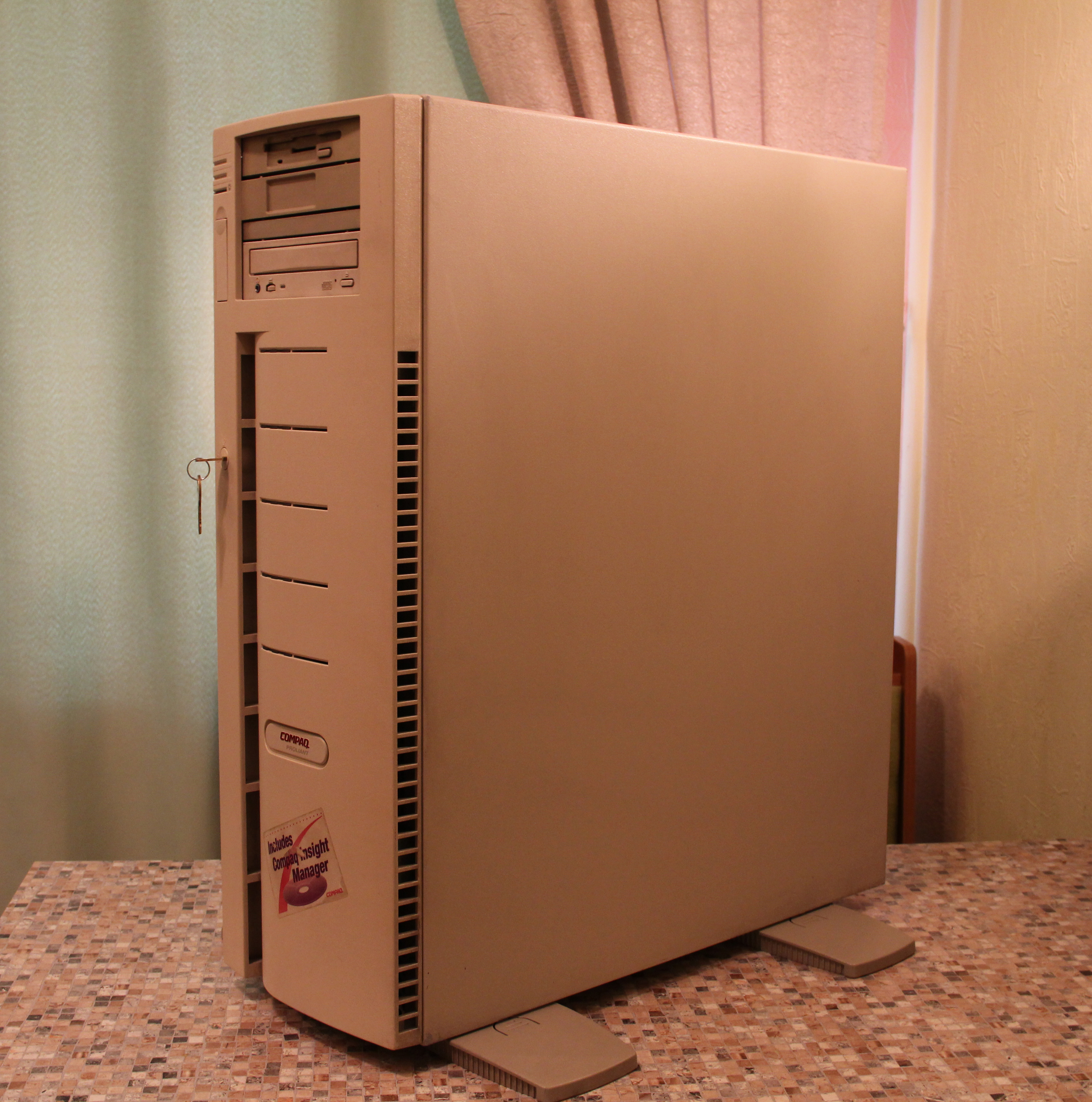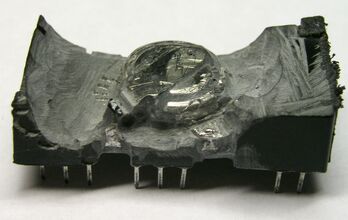Server machine from the mid 90s
Greetings Today, a product from Compaq has come to my table. This is the “proliant 1000” server, or rather its version called system 3120.

The exact date of production of this machine is not unknown, but you can say something like 95/96. In times of relevance, he worked at a bank (most likely a depository).
Around 2006, it was written off, and in August 2017 it was bought by me on the Internet flea market.
So, its configuration:
CPU - Pentium 60Mhz
RAM - 16MB
HDD - Fujitsu M2952S-512 (SCSI, 2.4 GB) x2
CD-ROM - SCSI CR-503BCQ
Video - Cirrus CL-GD5420 (512kb)
The server is assembled in a Full-Tower housing and has an opening front panel and retractable legs for stability. Behind the panel is a basket for 5 hot-swapping tales, of which I have only one busy.

Inside the case there is a jumper for stiffness and 2 fans for cooling.

Behind it has a ventilation grille, a sticker with information and technological holes. For what some holes under the plugs I did not understand.

As I wrote above, this monster has 16MB of RAM and a processor at 60Mhz. There is no name as such on it, unless it is a numerical designation.

The processor is firmly soldered to the board and remove it is not possible.
Although 16 MB of memory is already soldered on the motherboard, there are also 4 slots for SIMM 72pin slats.
It is worth making a small remark here, I tried to expand the memory to 48MB, but it turned out that all 4 slots represent a single memory bank and different memory simply will not work there. In the photo above you can see different modules, and below are all the modules I have.

To connect the expansion cards used here bus ExtendedISA (EISA). This bus extends the capabilities of the ISA up to 32 bits and increases the address space to 4GB. EISA is also a ISA superset, which means full mechanical and electrical compatibility with 8 and 16 bit boards.
There is also an integrated SCSI controller on the motherboard, which also hangs on this bus and is defined as a device in slot 8.
The utility for setting the BIOS is not sewn into flash memory, but lies on the disk and is a program running from DOS, you can install only expansion cards certified by Compaq, for the rest there will simply not be any configuration files and the BIOS will not issue them the required resources system. So even though EISA has full compatibility with ISA, here it doesn’t play any role at all.
The DALLAS DS1497 microcircuit is responsible for storing the CMOS settings and the real-time clock. Such microcircuits were equipped with a lithium battery and, according to the manufacturer, could store settings for up to 10 years. My chip has been holding them for almost 20 years now! If it still sits, then at the bottom of the board there is a connector for connecting an external battery (Below is a chip with a sawed-down case).

Now there are 2 cards installed in it:
1) “SMART ARRAY CONTROLLER” - this controller is capable of holding an array of 5 SCSI hot-swap disks + 2 more external devices through an adapter. For what it costs 3 batteries, I do not know, if you know - write in the comments.

This is the block of hot-plug disk slots itself (I would be grateful if you write what kind of plug hangs on its cable).

2) Network card from 3COM: “Fast EtherLink 3C597-TX” in EISA version.

By the way, judging by the markings on the case in the server there used to be 2 more cards, one of which is a video adapter!
There are two disks in it, but I thought of taking a picture of only one, here it is. Here it is presented inside the adapter on the 5.25 "bay. This is the system disk and the configuration utility and the server OS are stored on it.

There is also a CD-Rom and floppy disk drive, I forgot to take a photo of them.
The OS here is DOS 6.22 and the bootable from it, Novell NetWare version 4.11. McAfee NetShild 4.60 is installed as an anti-virus, and it lacks enough memory to run.
If you understand this, then perhaps you will be interested.

By tradition, I insert a startup video, in it you can see that utility and an attempt to start the server. Be careful, loud hum!
PS I will not do posts very often, for now I’m busy building other retro computers and fixing them. So, for example, now I am looking for 486 percent for 3 socket and an intelligent master in Barnaul. Thank you for reading!

The exact date of production of this machine is not unknown, but you can say something like 95/96. In times of relevance, he worked at a bank (most likely a depository).
Around 2006, it was written off, and in August 2017 it was bought by me on the Internet flea market.
So, its configuration:
CPU - Pentium 60Mhz
RAM - 16MB
HDD - Fujitsu M2952S-512 (SCSI, 2.4 GB) x2
CD-ROM - SCSI CR-503BCQ
Video - Cirrus CL-GD5420 (512kb)
Housing
The server is assembled in a Full-Tower housing and has an opening front panel and retractable legs for stability. Behind the panel is a basket for 5 hot-swapping tales, of which I have only one busy.

Inside the case there is a jumper for stiffness and 2 fans for cooling.

Behind it has a ventilation grille, a sticker with information and technological holes. For what some holes under the plugs I did not understand.

Filling
Motherboard
As I wrote above, this monster has 16MB of RAM and a processor at 60Mhz. There is no name as such on it, unless it is a numerical designation.

The processor is firmly soldered to the board and remove it is not possible.
Although 16 MB of memory is already soldered on the motherboard, there are also 4 slots for SIMM 72pin slats.
It is worth making a small remark here, I tried to expand the memory to 48MB, but it turned out that all 4 slots represent a single memory bank and different memory simply will not work there. In the photo above you can see different modules, and below are all the modules I have.

To connect the expansion cards used here bus ExtendedISA (EISA). This bus extends the capabilities of the ISA up to 32 bits and increases the address space to 4GB. EISA is also a ISA superset, which means full mechanical and electrical compatibility with 8 and 16 bit boards.
There is also an integrated SCSI controller on the motherboard, which also hangs on this bus and is defined as a device in slot 8.
The utility for setting the BIOS is not sewn into flash memory, but lies on the disk and is a program running from DOS, you can install only expansion cards certified by Compaq, for the rest there will simply not be any configuration files and the BIOS will not issue them the required resources system. So even though EISA has full compatibility with ISA, here it doesn’t play any role at all.
The DALLAS DS1497 microcircuit is responsible for storing the CMOS settings and the real-time clock. Such microcircuits were equipped with a lithium battery and, according to the manufacturer, could store settings for up to 10 years. My chip has been holding them for almost 20 years now! If it still sits, then at the bottom of the board there is a connector for connecting an external battery (Below is a chip with a sawed-down case).

Expansion Boards
Now there are 2 cards installed in it:
1) “SMART ARRAY CONTROLLER” - this controller is capable of holding an array of 5 SCSI hot-swap disks + 2 more external devices through an adapter. For what it costs 3 batteries, I do not know, if you know - write in the comments.

This is the block of hot-plug disk slots itself (I would be grateful if you write what kind of plug hangs on its cable).

2) Network card from 3COM: “Fast EtherLink 3C597-TX” in EISA version.

By the way, judging by the markings on the case in the server there used to be 2 more cards, one of which is a video adapter!
Storage devices
There are two disks in it, but I thought of taking a picture of only one, here it is. Here it is presented inside the adapter on the 5.25 "bay. This is the system disk and the configuration utility and the server OS are stored on it.

There is also a CD-Rom and floppy disk drive, I forgot to take a photo of them.
The OS here is DOS 6.22 and the bootable from it, Novell NetWare version 4.11. McAfee NetShild 4.60 is installed as an anti-virus, and it lacks enough memory to run.
Sticker closeup.
If you understand this, then perhaps you will be interested.

By tradition, I insert a startup video, in it you can see that utility and an attempt to start the server. Be careful, loud hum!
PS I will not do posts very often, for now I’m busy building other retro computers and fixing them. So, for example, now I am looking for 486 percent for 3 socket and an intelligent master in Barnaul. Thank you for reading!
